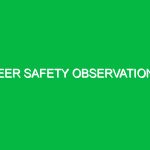Introduction to Safety Leadership for Supervisors
Safety leadership for supervisors is a crucial aspect of the Health, Safety, and Environment (HSE) domain. It involves not only understanding safety protocols but also actively promoting a safety-first culture within the workplace. Supervisors play a pivotal role as they bridge the gap between management and frontline employees. Their actions and attitudes significantly impact how safety policies are perceived and implemented. Creating a safe work environment is not just about adhering to regulations; it’s about fostering a culture where safety is valued and prioritized at every level.
Understanding the Importance of Safety Leadership
The significance of safety leadership cannot be overstated. In industries such as construction, manufacturing, and oil and gas, the risks are elevated, making effective safety leadership essential. Supervisors set the tone for safety practices. Their commitment to safety influences team behaviors and attitudes. For instance, a supervisor who actively participates in safety drills and engages in discussions about safety concerns encourages their team to adopt similar behaviors.
Identifying Hazards and Risks Associated with Safety Leadership
Effective safety leadership begins with a thorough understanding of potential hazards. Supervisors must be adept at identifying risks that can lead to accidents or injuries. These can range from physical hazards like machinery and chemicals to ergonomic risks associated with repetitive motions.
Common Hazards in the Workplace
- Physical Hazards: These include equipment malfunctions, slips, trips, and falls, which are prevalent in many industries.
- Chemical Hazards: Exposure to harmful substances can occur in environments where chemicals are used, stored, or disposed of improperly.
- Biological Hazards: These risks are particularly relevant in healthcare settings, where exposure to pathogens can pose significant threats.
- Ergonomic Hazards: Poor workstation design and improper lifting techniques can lead to musculoskeletal disorders.
- Psychosocial Hazards: Workplace stress, harassment, and bullying can adversely affect mental health and overall well-being.
Assessing Risks
Once hazards are identified, supervisors must assess the associated risks. This involves determining the likelihood of an incident occurring and the potential severity of its consequences. For example, a construction site with heavy machinery poses a high risk of injury if safety protocols are not strictly followed. Conducting regular risk assessments, utilizing tools such as the Job Safety Analysis (JSA), is vital for effective risk management.
Safety Precautions and Best Practices for Supervisors
Implementing safety precautions requires a proactive approach. Here are some best practices for supervisors to consider:
1. Develop a Safety Culture
A strong safety culture is foundational for effective safety leadership. This involves encouraging open communication where employees feel safe to report hazards or unsafe practices without fear of reprisal. A personal anecdote illustrates this: a supervisor I once worked with initiated a “safety suggestion box,” allowing team members to express their concerns anonymously. This simple act significantly increased reporting rates of safety hazards and improved overall morale.
2. Provide Comprehensive Training
Training is essential. Supervisors should ensure that employees receive thorough training on safety protocols, equipment usage, and emergency procedures. This training should be ongoing, not just a one-time event. Regular refreshers can help keep safety at the forefront of employees’ minds.
3. Lead by Example
Supervisors should model safe behavior. If a supervisor routinely neglects to wear personal protective equipment (PPE), it sends a message that safety is not a priority. By consistently following safety protocols, supervisors reinforce the importance of these practices to their teams.
4. Conduct Regular Safety Audits
Regular audits help identify areas for improvement. Supervisors should schedule frequent inspections to ensure compliance with safety standards. These audits not only assess physical conditions but also evaluate the safety culture within the team. For instance, during one audit, a supervisor discovered that a crucial piece of safety equipment was not being used correctly, which led to immediate retraining sessions.
5. Encourage Reporting and Feedback
Encouraging employees to report near misses or hazards is vital for continuous improvement. Supervisors should create an environment where feedback is welcomed. Implementing a non-punitive reporting system can lead to valuable insights into potential risks.
6. Implement Emergency Preparedness Plans
Every workplace should have a clear emergency preparedness plan in place. Supervisors must ensure that all employees are familiar with evacuation routes, assembly points, and emergency contacts. Conducting regular drills can help reinforce these procedures, ensuring that everyone knows how to respond in a crisis.
Regulations and Standards Governing Safety Leadership
Safety leadership is also guided by various regulations and standards. Familiarity with these can enhance a supervisor’s effectiveness. Key regulations include:
1. Occupational Safety and Health Administration (OSHA) Standards
In the United States, OSHA sets and enforces standards to ensure safe working conditions. Supervisors must be aware of these regulations to effectively manage safety in their workplaces.
2. ISO 45001
This international standard outlines requirements for occupational health and safety management systems. It provides a framework for organizations to improve employee safety, reduce workplace risks, and create better, safer working conditions.
3. National Fire Protection Association (NFPA) Codes
These codes provide guidelines for fire safety in the workplace. Supervisors must ensure compliance with these codes to mitigate fire hazards effectively.
Conclusion: The Impact of Effective Safety Leadership
In conclusion, safety leadership for supervisors is a multifaceted responsibility that extends beyond mere compliance with regulations. It involves creating a culture of safety, actively engaging with employees, and continuously assessing and improving safety practices. The role of a supervisor is not just to enforce rules but to inspire their team to take ownership of their safety. By fostering a positive safety culture, supervisors can significantly reduce workplace incidents, enhance employee morale, and ultimately contribute to the success of their organizations.
In a world where workplace hazards are ever-present, the importance of effective safety leadership cannot be overlooked. Supervisors are the linchpins in ensuring that safety remains a top priority, leading to healthier, safer, and more productive work environments.


